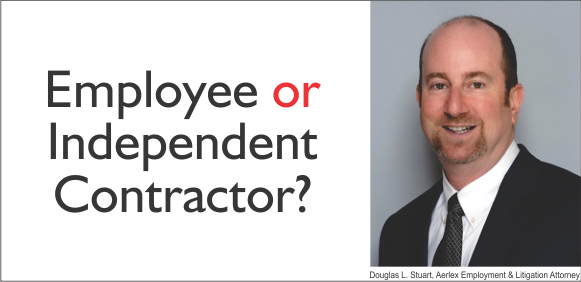Employee or Independent Contractor Classification Update
EMPLOYEE OR INDEPENDENT CONTRACTOR UPDATE: A NEW CALIFORNIA RULING FURTHER LIMITS INDEPENDENT CONTRACTOR CLASSIFICATION
In 2015, Aerlex presented a two-part online series entitled “Employee or Independent Contractor?” which examined the question of whether pilots and cabin attendants could be treated as independent contractors rather than employees. At that time, we concluded that the State of California might be following the nationwide trend toward classifying more workers as employees and cautioned that a proper analysis should be undertaken to avoid misclassifying workers.
Misclassification can result in lawsuits by employees and governmental actions costing employers far more than what they save in treating workers as independent contractors. In response to what it perceives as a continuing problem with misclassification of workers as independent contractors, the California Legislature has enacted laws imposing substantial civil penalties on employers who willfully misclassify, or willfully aid in misclassifying, workers as independent contractors.
On April 30, 2018, the California Supreme Court decided Dynamex Operations West v. Superior Court and the Court’s unanimous decision left no doubt how the seven members of the state’s highest tribunal interpret the law. The issue in the Dynamex case related to the resolution of the employee or independent contractor question in one specific context: which standard applies, under California law, in determining whether workers should be classified as employees or as independent contractors for purposes of enforcing the California Wage Orders adopted by the California Industrial Welfare Commission (“IWC”). The IWC’s Wage Orders impose obligations on employers in various industries relating to minimum wages, maximum hours, and a limited number of very basic working conditions (such as minimally required meal and rest breaks) of California employees.
In the Dynamex Operations West case, two individual delivery drivers, suing on their own behalf and on behalf of a class of similarly situated drivers, filed a complaint against Dynamex Operations West, Inc. (Dynamex), a nationwide package and document delivery company. The drivers alleged that Dynamex had misclassified its delivery drivers as independent contractors rather than employees. They claimed that Dynamex’s alleged misclassification of its drivers as independent contractors resulted in Dynamex’s violation of the provisions of IWC Wage Order No. 9, the applicable state regulation governing the transportation industry, as well as various other laws. This is the same Wage Order that regulates much of the aviation industry in California, and applies “to all persons employed in the transportation industry, whether paid on a time, piece rate, commission, or other basis,” except for persons employed in administrative, executive, or professional capacities, who are exempt from most of the Wage Order’s provisions.
The California Supreme Court concluded that, in determining whether a worker is properly considered the type of independent contractor to whom the Wage Order does not apply, it is appropriate to look to a standard commonly referred to as the “ABC” test. Under this test, a worker is properly considered an independent contractor to whom a Wage Order does not apply only if the hiring entity establishes: (A) the worker is free from the control and direction of the hirer in connection with the performance of the work, both under the contract for the performance of such work and in fact; (B) the worker performs work that is outside the usual course of the hiring entity’s business; and (C) the worker is customarily engaged in an independently established trade, occupation, or business of the same nature as the work performed for the hiring entity.
The Court explained that an individual worker who has been hired by a company can properly be viewed as the type of independent contractor to which the Wage Order was not intended to apply only if the worker is the type of traditional independent contractor — such as an independent plumber or electrician — who would not reasonably have been viewed as working in the hiring business. Such an individual would have been realistically understood, instead, as working only in his or her own independent business.
Writing for the unanimous Court, Chief Justice Cantil-Sakauye provided the following example: a store that hires an outside plumber to fix a leak, or an electrician to install a new line, could consider them contractors. But a clothing manufacturer that hires seamstresses who work at home to make dresses that the company will sell has hired them to perform work in its usual line of business and must pay them as employees.
Although this new Supreme Court ruling does not apply to every situation in California, it is consistent with Aerlex’s previous prediction that California would continue to limit the classification of workers as independent contractors. Every California employer in the aviation industry must continue to devote sufficient time and resources into properly hiring and classifying their workers, including flight crew, ground crew and office staff. After the decision in Dynamex, it will be even more difficult to classify your workers as independent contractors.
To contact Aerlex litigator and labor law expert Douglas Stuart about labor or litigation issues, please call 310-392-5200 or write to dstuart@aerlex.com.

